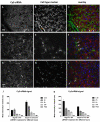Biodistribution of small interfering RNA at the organ and cellular levels after lipid nanoparticle-mediated delivery
- PMID: 21804077
- PMCID: PMC3261601
- DOI: 10.1369/0022155411410885
Biodistribution of small interfering RNA at the organ and cellular levels after lipid nanoparticle-mediated delivery
Abstract
Chemically stabilized small interfering RNA (siRNA) can be delivered systemically by intravenous injection of lipid nanoparticles (LNPs) in rodents and primates. The biodistribution and kinetics of LNP-siRNA delivery in mice at organ and cellular resolution have been studied using immunofluorescence (IF) staining and quantitative polymerase chain reaction (qPCR). At 0.5 and 2 hr post tail vein injection of Cy5-labeled siRNA encapsulated in LNP, the organ rank-order of siRNA levels is liver > spleen > kidney, with only negligible accumulation in duodenum, lung, heart, and brain. Similar conclusions were drawn by using qPCR to measure tissue siRNA levels as a secondary end point. siRNA levels in these tissues decreased by more than 10-fold after 24 hr. Within the liver, LNPs delivered siRNA to hepatocytes, Kupffer cells, and sinusoids in a time-dependent manner, as revealed by IF staining and signal quantitation methods established using OPERA/Columbus software. siRNA first accumulated in liver sinusoids and trafficked to hepatocytes by 2 hr post dose, corresponding to the onset of target mRNA silencing. Fluorescence in situ hybridization methods were used to detect both strands of siRNA in fixed tissues. Collectively, the authors have implemented a platform to evaluate biodistribution of siRNA across cell types and across tissues in vivo, with the objective of elucidating the pharmacokinetic and pharmacodynamic relationship to guide optimization of delivery vehicles.
© The Author(s) 2011
Conflict of interest statement
All authors are full-time employees of Merck & Co, Inc.
Figures





Similar articles
-
Quantitation of physiological and biochemical barriers to siRNA liver delivery via lipid nanoparticle platform.Mol Pharm. 2014 May 5;11(5):1424-34. doi: 10.1021/mp400584h. Epub 2014 Apr 1. Mol Pharm. 2014. PMID: 24588618
-
Technologies for investigating the physiological barriers to efficient lipid nanoparticle-siRNA delivery.J Histochem Cytochem. 2013 Jun;61(6):407-20. doi: 10.1369/0022155413484152. Epub 2013 Mar 14. J Histochem Cytochem. 2013. PMID: 23504369 Free PMC article. Review.
-
Influence of particle size on the in vivo potency of lipid nanoparticle formulations of siRNA.J Control Release. 2016 Aug 10;235:236-244. doi: 10.1016/j.jconrel.2016.05.059. Epub 2016 May 26. J Control Release. 2016. PMID: 27238441
-
Biodistribution and metabolism studies of lipid nanoparticle-formulated internally [3H]-labeled siRNA in mice.Drug Metab Dispos. 2014 Mar;42(3):431-40. doi: 10.1124/dmd.113.055434. Epub 2014 Jan 3. Drug Metab Dispos. 2014. PMID: 24389421
-
Lipid Nanoparticle Technology for Clinical Translation of siRNA Therapeutics.Acc Chem Res. 2019 Sep 17;52(9):2435-2444. doi: 10.1021/acs.accounts.9b00368. Epub 2019 Aug 9. Acc Chem Res. 2019. PMID: 31397996 Review.
Cited by
-
Delivery of oligonucleotide-based therapeutics: challenges and opportunities.EMBO Mol Med. 2021 Apr 9;13(4):e13243. doi: 10.15252/emmm.202013243. Epub 2021 Apr 6. EMBO Mol Med. 2021. PMID: 33821570 Free PMC article. Review.
-
Nonclinical pharmacokinetics and biodistribution of VSV-GP using methods to decouple input drug disposition and viral replication.Mol Ther Methods Clin Dev. 2022 Dec 28;28:190-207. doi: 10.1016/j.omtm.2022.12.013. eCollection 2023 Mar 9. Mol Ther Methods Clin Dev. 2022. PMID: 36700123 Free PMC article.
-
Lysosomal Storage Disease-Associated Neuropathy: Targeting Stable Nucleic Acid Lipid Particle (SNALP)-Formulated siRNAs to the Brain as a Therapeutic Approach.Int J Mol Sci. 2020 Aug 10;21(16):5732. doi: 10.3390/ijms21165732. Int J Mol Sci. 2020. PMID: 32785133 Free PMC article. Review.
-
Pharmacokinetics and biodistribution of recently-developed siRNA nanomedicines.Adv Drug Deliv Rev. 2016 Sep 1;104:93-109. doi: 10.1016/j.addr.2015.12.004. Epub 2015 Dec 10. Adv Drug Deliv Rev. 2016. PMID: 26686832 Free PMC article. Review.
-
Lipid nanoparticle-encapsulated, chemically modified anti-adenoviral siRNAs inhibit hepatic adenovirus infection in immunosuppressed Syrian hamsters.Mol Ther Nucleic Acids. 2023 May 17;32:923-936. doi: 10.1016/j.omtn.2023.05.016. eCollection 2023 Jun 13. Mol Ther Nucleic Acids. 2023. PMID: 37346978 Free PMC article.
References
-
- Baldwin L, Flanagan BF, Hunt JA. 2005. Flow cytometric measurement of phagocytosis reveals a role for C3b in metal particle uptake by phagocytes. J Biomed Mater Res A. 73:80–85 - PubMed
MeSH terms
Substances
LinkOut - more resources
Full Text Sources
Other Literature Sources
Miscellaneous

